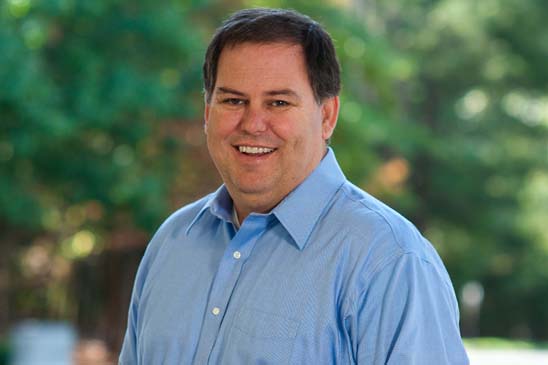Insights > Powering Through: Entergy's Katrina Stories: Robbin Jeter, Vice President of Customer Service, Entergy Mississippi, Inc.
Powering Through: Entergy's Katrina Stories: Robbin Jeter, Vice President of Customer Service, Entergy Mississippi, Inc.
08/26/2015

“You know how we always say that at Entergy, we hope for the best, but plan for the worst?” asked Robbin Jeter, who served as a central region manager in Jackson when Hurricane Katrina struck. “Well, in the case of Hurricane Katrina, we got the worst. I don’t think any of us ever really thought we’d have hurricane-force winds in Jackson.”
As the legendary storm approached central Mississippi, Jeter and his team of employees continued to assess just how strong the hurricane was, adjusting plans as necessary. The group studied storm-tracking information, office staffing, scouting, material needs and staging sites for restoration.
Jeter called all of his employees into a downtown Jackson office that Monday, where they rode out the storm so they could get out quickly to begin assessing damage after the weather had passed. All the while, they were hoping that, in the end, such dedicated preparation would prove to be overkill.
But it didn’t.
On the afternoon of Aug. 29, 2005, Hurricane Katrina roared through central Mississippi. In the hours and days following the storm, employees at Entergy Mississippi, Inc. learned just how valuable their planning had been.
“It was a mess,” said Jeter. “When we began surveying the damage, we knew it was going to be a long road. Those of us in distribution operations don’t panic about those kinds of things, but we could tell that this storm was bigger in scope than nearly anything we’d ever done. We knew it would be one heckuva challenge.”
That first night, Jeter returned home very late to check on his home and his family.
“I tried to make sure my structure was still there,” he noted. “I had limbs and things like that all over the yard, but no serious damage to my house. I was lucky. I checked on my wife and kids and spent that first night after the storm at home.”
It would be one of the last times Jeter would see his family for several days. His wife, Peggy, and two twin sons went to stay with a friend, and Jeter got to work. In the days following Katrina, he’d arrive at the Distribution Operations Center by 6 a.m. and work all day and into the night. He’d go home around midnight for a shower and a change of clothes, circle back through the DOC at about 1:30 a.m. for one last check, then head to the company’s South Street office to sleep.
The DOC was a flurry of activity. Jeter and his team took a divide and conquer approach, segmenting the Jackson area and assigning each part to a different restoration team. He was also spending time updating customer service managers about progress and expectations, managing the mutual assistance crews arriving to help and working to restore hospitals and emergency response partners.
“Early on, there were issues with water and sewer services all over the metro area,” added Jeter. “There were just so many people in and out of the DOC, phones ringing constantly, talk on the radio constantly. There were days it almost felt like the New York Stock Exchange.”
Employees at the DOC managed this frenzied pace, working from dawn until midnight most days, for the first few days of the restoration. On day four, though, fatigue began to set in.
“I could see people starting to get tired and stressed,” noted Jeter. “We knew we had to push through that, so I started encouraging our folks to get home before midnight as best I could. We needed to recharge, because it was going to be a long battle.”
As employee teams began to get more circuits back on, morale improved. More critical services – such as water, hospitals, gas stations and grocery stores – had been restored, and such progress focused employees on the end goal.
"Our initial estimate for total restoration was 18 days,” said Jeter. “Later, we refined that to 14 days. I think that, when it was all said and done, we restored every customer who could take service somewhere around day 11 or 12. To make that happen, our employees had to step up quickly and lead. Nearly everyone had to take on a different role to get that restoration done. It was very stressful, but they did it. It just goes to show you that we can do great things when faced with adversity.”

